If you’ve been interested in surfing for a few time or for some years already, this guide will help you understand and learn a bit more this sport. It will give you the essential information so that you can start learning from home. We hope that this guide will give you the motivation to take the plunge or to perfect after have read this article! Lanzarote surfing courses

What is surfing ?
Surfing is a sport that consists in standing up on a surfboard and riding breaking waves towards the shore. This exigent discipline requires a long learning process. It’s a really addictive sport that requires a good physical condition and will give you fitness.
The beginning of surfing
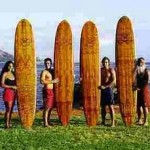
The story of surfing started 500 years ago! Riding waves with a wooden board is an act that takes its origins in Polynesia; the first surfers were fishermen who discovered riding waves as an efficient method of getting to shore with their catch.
In the 19th century, the explorer James Cook was the first to discover this practice; the island’s inhabitants were using wooden boards to ride on the waves. This practice was called He’e nalu, that is to say “slide on the wave” in Hawaiian. And… if you want to know the story, when these islands were colonized, James Cook totally forbade this practice. In the 20th century, in 1950 and 1960, surfing reappeared and became popular on the Californian and Australian coasts, thanks to the Hawaiian pioneer Duke Kahanamoku and to the progress of board manufacturing (boards in extruded polyurethane foam, Polyester resin and fiberglass).
The evolution of surfing
Surfing at that time has nothing to do with current surfing. Before, the boards were very simple, and in wood. But everything changed with Oscar Rodriguez, the man who introduced new techniques, and created new designs and materials for the boards.
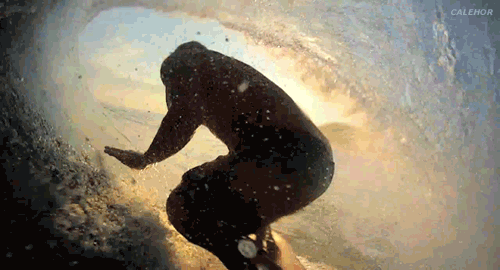
In Europe, surfing became famous thanks to Jimmy Dix, who surfed the waves of Cornwall (1937) with a board of the Hawaiian surf club. Then, at the end of the 1950s, surfing really became popular as Rosnay, Barland and Moraiz, three boys who became surf legends, started surfing in Biarritz.
In 1963 in Spain, Jesus Fiochi (Cantabria) was the first to surf; he reproduced what the French guys did, in Santander. From that event, surfing was developing on the northern coast, and in the 1970s, it was spread in the rest of the country and in the Canary Islands, which offers a large number of great beaches.
Keep in mind that we also offer a junior surf camps. Give your children the best summer of their lives, practicing surfing, meeting people from all over the world, and practicing languages. We can tell you in advance that the kids always come back for more!
The different types of surfing
Different types of boards exist; we group them in function of their size:
- Shortboard (1.5m to 2.1 long). The narrowest and thinnest ones allow better manoeuvrability and are made for bigger waves but they don’t pick up lot of speed. You have to catch the wave at the right time to maximize the speed of your surfboard.
- Longboard or Malibu, the classic type of board. It’s a board longer than or equal to 2.75m, thicker and larger. With this board you’ll pick up more speed and make longer manoeuvers.
Depending on the waves, you’ll have:

- Surfing: on medium size waves
- Big waves surfing, on waves higher than 2m
More variants:
- Kneeboard: a sport that consists of sliding on the wave in a kneeling position on a specific board.
- Bodyboard: it is practiced lying on a small board. This sport is very popular as it is less dangerous and more accessible.
- Paddle: a sport that consists of paddling while standing on a large and wide board, with a paddle.
- Tow-in: a surfing technique which uses artificial assistance (a jet ski) to allow the surfer to catch faster moving waves.
- Windsurfing: it consists of a board usually two to four meters long, powered by the effect of the wind on a sail.
- Kitesurf: a sport consisting of moving with a board while being towed by a kite.

The equipment
Here is the list of the equipment you’ll need:
- The board, of course!
- A wetsuit, or a lycra, that can protect you from the low temperature of the water, sun rays, blows and scratches. The thickness of the wetsuit is chosen according to the temperature of the water: in winter, a thick one (5/4mm or 4/3mm depending on where you go surfing), and in summer, a short and finer.
- The wax, that you put on the board so that you don’t slip. Like the wetsuit, the wax is chosen according to the temperature of the water. It’s possible to replace the wax or to complete it with a pad. The pad is a self-adhesive, non-slip rubber foam surface placed at the back of a board.
- A beautiful beach!
This is the basic equipment; other accessories exist but they only have a decorative goal.
The surfboards
Choosing your surfboard is a great moment in the start of your surfing adventure!!
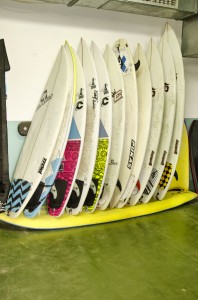
Generally, the choice of the board depends on the weight, the size, the level of experience, but also of the type of board (shortboard or longboard) and the wave that you want to surf. It is obvious that beginners will rather take a large and wide board that floats well, so that they can get up more easily.
With some experience, you can choose a shorter and finer board. But also think that you can have a versatile board which allows you to surf both small and bigger waves.
A board is made in 2 steps: the shape (the shaping of the foam), the glazing (the covering of the board with a fiberglass and polyester).
The composition of a surfboard:
- The outline: the outer line of a surfboard, the shape that we see from above.
- The nose: it is the first third of your board. It is slightly curved to facilitate manoeuvrability.
- The rocker: it is the bottom curve of the surfboard. It is most apparent when the board is laid upon a flat surface. If it is very pronounced, the board will be more manoeuvrable but ride less fast; if it’s flat it will give more speed but less manoeuvrability for the radical manoeuvres.
- The plug: the hook for the leash.
- The tail: the last part of the board. The tail shape influences the hold and release on the surface of the wave. More angular shapes will allow you to make sharper turns; a rounder shaped tail will enable rounder and smoother turns.
- The rails, ie the edges of the board. Round edges will adhere better in the wave, sharp rails will give more speed, and curved rails more manoeuvrability.
- The bottom: this is the underside of the board, often concave to facilitate the flow of water and make you ride better.
- The leash: the plastic cord that links to the board with a velcro.
- The fins, under the board and at the back, which influence the behaviour of the board.
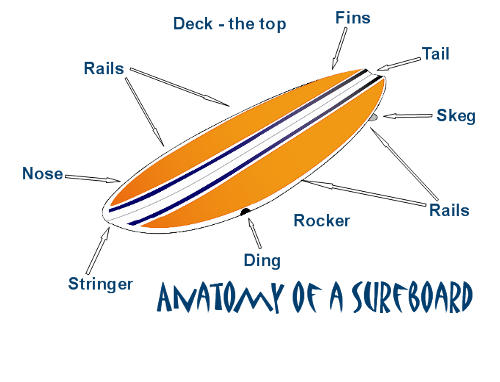
The different types of surfboards
- Shortboard: this type of board is the most common. Short and narrow, it is made for surfers who have a minimum of technique.
- Evolutive: boards of 1.90 to 2.20 m for a width between 49 and 52 cm. Large, thick, this style of board offers a lot of possibilities of manoeuvres.
- Fish: these boards are shorter and wider than the evolutive. From 1.70 to 1.90 m, they are very wide (52cm or more), with a lot of volume, a rounded outline. It is a versatile board, perfect for small waves.
- Mini Malibu: boards with a length between 2.20 and 2.60 meters, a wide between 52 and 56cm. They are rather stable, which allows beginners and intermediate surfers to have fun.
- Gun: a board specific to the big wave surfing (2.10 meters and more). It is reserved for experts.
- Longboard or Malibu: board with a length of 2.75 meters (9 feet) minimum, quite wide and thick. The main quality of this board is that it offers a smooth and incredible feeling of riding, on all waves. The longboard has its own manoeuvres: nose riding, knee turn, hang five (put a foot on the nose), hang ten (put both feet on the nose).
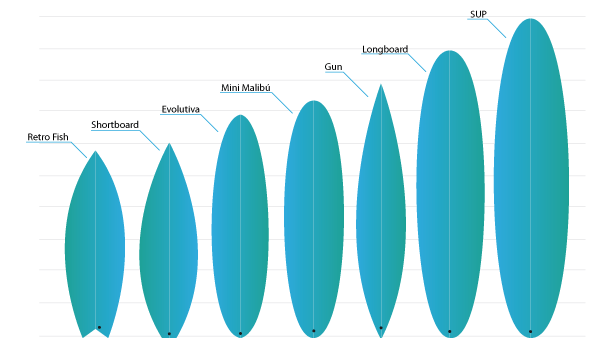
The style of a board is defined by its size. The larger the size, the less manoeuvrable it is, but you can have fun moving around and enjoying the speed it provides. The thicker it is, the more resistant, voluminous it will be.
Many factors must be taken into account while choosing the board, but the most important are: buoyancy, manoeuvrability and the type of waves you want to surf.
Some precautions
A surfboard is expensive, so take care of it! Here are a few tips:
- Do not leave the board inside the car, or outdoors. Cover it with and keep it in a dry place. The boards are very sensitive to the sun’s rays: they can discolour, go ruined and lose resistance.
- If the board has an impact, make it repaired by a specialist. Don’t wait; the materials that compose the board from the inside are not resistant to the water. The foam inside can rot, become heavier and unstable, with the accumulation of water that can infiltrate.
- Store the board in an horizontal position. It’s not recommended to put it against a tree or a wall; a board is rather unstable and a fall can cause irreversible damage.
- Clean it with a special brush to remove the old wax.
The basics
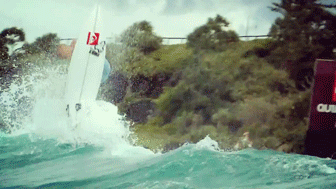
Let’s start with the take-off and the position of the body on the board!
The take-off
Before you learn how to do the take-off, ask yourself: am I “goofy” (right foot in front, left foot in the back) or “regular” (left foot in front)? To find out the answer, ask a friend to stand behind you and push you gently in the back. The dominant foot is the one that that is in front. Is it your right foot? Then you are goofy. The left one? Then you are regular. Watch out however, this technique is not always worth, there are exceptions!
Before trying to do the take-off in the water, train yourself outside (on the board, on the sand, in your garden…). The more you train, the easier the take-off will be.
The position of the body
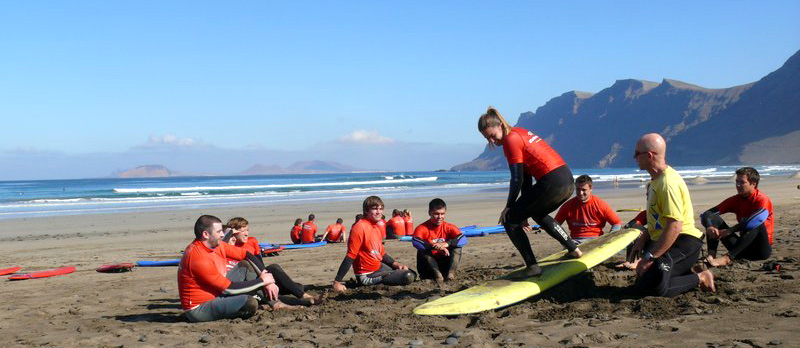
First, lie down on the board, hands on the board at the level of your pectorals. Raise your head and your shoulders, and bend your back. Put your back foot at the level of the knee of the other leg, then put your dominant foot between your arms. And get up! Repeat this movement several times to assimilate it.
Once you’re stood up, put your feet parallel to each other. Your body must be at the centre of the board, never on one of the edges, because you will lose balance and fall. Your body must be perpendicular to the board.
Focus on the position of your body when you do the take-off. Your legs are bent, your back knee slightly inward, your back straight, your shoulders in the direction of the board and your arms forward.
Paddle

Having a good paddle is very important if you want to take many waves. Paddling is quite tiring, so train often!
For the beginning, it is better to catch the foam of the waves. Be careful: when you spot a foam you want to take, look around you to see if there is someone in front of you, lie on the board, paddle to reach the speed of the wave (otherwise it will overtake you and you won’t take it), and when the wave pushes you, get up! Once you know how to get up on the foams, you can try to take the waves that are outside.
The manoeuvres
Now that you know how to get up on the board, learn how to follow the wall of the wave that has not broken yet. Once it’s done, you can make a lot of manoeuvres
Here is the list of famous manoeuvres:
- Take-off: the moment you get up on the board to take the wave.
- Bottom turn: the turn you make after the take-off, at the bottom of the wave. Once you have the impulse and you are down the wave, head to the part of the wave that has not broken yet. This turn allows you to join and follow the wall of the wave.
- Cut back: unlike the Bottom Turn, once you are on the wall but it’s not powerful, make a 180 ° turn to return to the wave and regain power.
- Reentry (or carve): follow the wall of the wave to the lip and make a sharp 180 ° turn to go down.
- Floater: consists of surfing the lip of the wave that will break.
- Tube: ride inside the tube created by a hollow wave. It is the most spectacular and difficult figure of surfing.
- Aerial: jump over the wave and catch the wave again. Among these manoeuvres, we distinguish the “grabs” (during the jump, catch the plank with the hands). One of the most spectacular aerials is the 360, when the surfer makes a complete turn in the air.
- Carve 360: make a complete turn with the board by slipping the back or pulling out of the wave.
- Snap: dry and fast braking of the board and slipping the rear. A kind of cut back that is more abrupt, and with a shorter turn.
- Roller: take the nose out of the board at the top of the wave and then go down the wall.
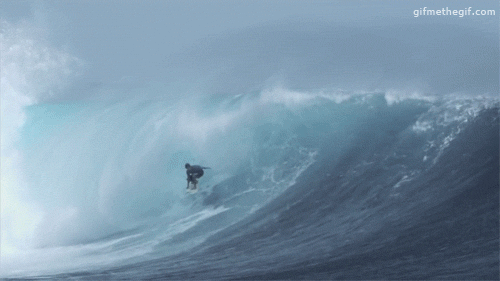
Figures with a Longboard:
- Hang Five: walk on the board and put one of the feet on the nose.
- Hang Ten: put both feet on the nose of the board. This requires good skills and a fast wave!
- Drop Knee: this is the classic longboard turn. It’s like a cut back but you have to bend the back leg until the knee rubs the board.
The waves
For surfing, the good waves are those that evolve and break gradually along the wall to the right or left. If the waves break on a rocky bottom with little depth, they will be more suitable for bodyboarding.
The parts of the wave
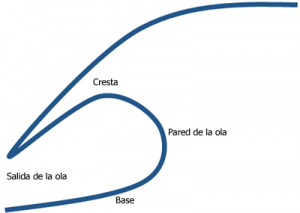
- The wall: the part of the wave that rises on the horizontal line, on which you make the take-off just before it breaks
- Lip: the upper part of the wave
- Shoulder: area of the wave that has not broken yet
- The curl: the heart of the wave, the hollow, the most powerful place where
- The tube: the space of the curl which is covered by the lip, where you can be covered by the wave
- The zone of impact: where the lip of the wave falls
- The peak: area where the wave begins to break
Types of waves
- Hollow: when the wave forms a hollow. This wave is very powerful, it gives speed and strength.
- Tube: hollow wave allowing to make deep tubes.
- Soft: wave that is not hollow, as a consequence much less powerful. It breaks slowly.
- Bar: when the wave breaks all of a sudden, all along at the same time, it is not suitable for surfing.
The sizes of the waves
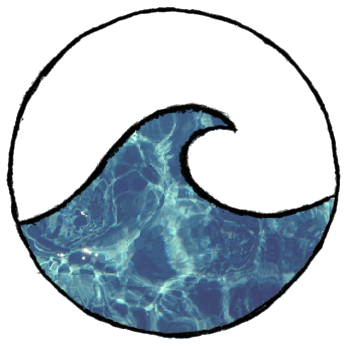
- Small: up to 1m. It is a current size.
- Medium: average or normal waves, up to 1.50m
- Large: 1.50m to 2m
- Big: 2m to 2.50m, the waves allow to take tubes
- Huge: above 2.50m
- Above, it is giant waves surfing.
International boating uses the Douglas scale to measure waves. But the measures also depend on the place and the cultures:
- In the Canary Islands and Hawaii, we measure the waves from behind
- In the rest of Spain, the front waves are measured, from the water level to the lip
Waves depending on where they break
- Beach Break: wave that breaks on a sandy bottom. It’s less violent but the wave is constantly changing with the tides and the changing sandbanks.
- Reef Break: wave breaking on a rocky or coral bottom. It is more powerful, hollower and dangerous.
- Shore Break: wave that breaks along the shore.
Depending on the bottom and the direction of the swell, we can distinguish two waves: the “rights” (when you are in the water, facing the beach, they break to the right), and the “lefts” (they break to the left).

The surfers are distinguished according to the waves
- Regular: they surf a right facing the wall, with your left foot in front.
- Goofy: they surf a left facing the wall, with the right foot in front.
- Frontside: they surf facing the wave.
- Backside: they surf with your back facing the wave.
The influence of wind on the waves
If you are surfing a beach break, know that the wind plays a decisive role in the shape and quality of the waves. The wind can be:
- On-shore: wind coming from the sea, which tends to crush the waves and chop. This wind makes the conditions less favourable for surfing.
- Off-shore: wind coming from the land, which digs the waves and softens the water surface, improving the surfing conditions.
- Side shore: side wind that does not really affect the quality of the waves.
- No wind. In truth these conditions produce “glassy” waves with a very smooth wall, ideal for surfing.
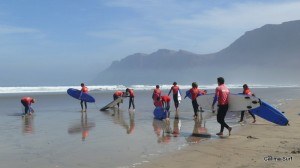
Although you are not a weather expert, it is important to understand and analyse the conditions of the beach: tides, highs and atmospheric pressure, among others.
The benefits of surfing
The practice of surfing brings plenty of benefits: you make friends, you discover incredible places, you are in contact with nature, you share your knowledge and experiences.
One of the most rewarding benefits is physical intake. In addition to relaxing, you combine an aerobic and invigorating workout, burn fat in the water and develop your muscles. You also do some cardio, work your arms, back, legs, buttocks. You improve your endurance, your coordination and your balance. It is a very complete sport!

The risks
Keep in mind that surfing can also bring some discomfort, injuries, diseases. The most common are:
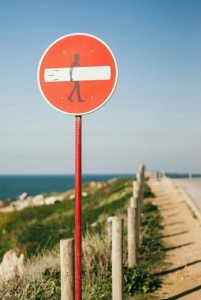
- Loss of body heat: being in an aquatic environment during a long time can make cold penetrate your body. This can cause uncoordinated moves, shivers, slower reflexes, cramps, stiffness, etc. You have to get out of the water as soon as you notice them. And think about wearing an appropriate wetsuit.
- Hyperostosis; it is bone formation in the ear, in response to cold and water. It requires surgical treatment. To avoid this phenomenon it is better to use ear plugs.
- Otitis: inflammation of the ear canal because of the constant entry of water.
- Chondrite: inflammation of the ribs. It is very painful because we constantly lean on the board.
- Problems of articulation, due to repetitive moves. This often affects the shoulders and knees.
- Lumbar and cervical lesions, due to the position you have when you paddle.
- Punches and cuts are impossible to avoid especially when you are learning. The board itself can be a weapon. Protections can be put on the nose of the board to prevent this risk. Similarly, wearing a helmet can protect you. It is indispensable if you are going to surf big waves with rocky bottoms.
Having a healthy life is the best way to be in good physical and mental condition and be a super surfer. Practice swimming, stretching, jogging, etc. Have a good quality of sleep, a proper diet that gives vitamins, minerals and all the nutrients the body needs.
Never forget to warm up and stretch before you go surfing. This is definitely the best prevention and preparation to start a good surfing day. Normally it doesn’t take more than five to ten minutes. You can include small strides and jumps with your feet together, you can turn the ankles, knees, waist, neck and shoulders.

Tips for the beginners
To achieve your projects successfully, here are some rules and tips to follow:
- The currents are very common. If you are drawn into a current, keep calm and stay on the board. Wait for a wave which can take you back to the beach. In extreme cases, do not fight and ask the surfers for help.
- Don’t forget the ecological responsibility we have towards our planet. We must leave the beach as if no one had been there. Know that there is a non-profit organization called Surfrider Foundation, which carries out many actions and raise awareness among people about the environment.
- Surfers who start catching the wave in the area close to the breaking wave have priority over other surfers. You have to be very careful not to cause an accident nor a problem.
- Local surfers have priority over foreigners.
- It is better to start surfing in a surf school in order to have the basic knowledge and skills, and to avoid bad habits.
- Practice a lot on the foams to master the first step.
- Don’t rush, persevere and have fun!
Various information
- In the 1950s in the United States started a boom of surf videos, which made it very popular around the world. Here are some of them: Hawaiian Surfing Movie (1953), Gidget (1959), The Endless Summer (1966), The Great Wesnesday (1970), Point Break (1990), In God’s Hands (1999).
- A style of music was born with this sport; the precursor is Dick Cale with Fender Estratocaster.
- The Association of Surfing Professionals (ASP) includes 2 circuits: WQS and WCT. These ones are trials carried out on various spots all around the world.
- There are other competitions such as Pro Junior, Masters, Longboard, etc.
That is all! We hope we made you like this sport, and that your potential worries disappeared during the reading! If you want to start learning, you can choose to do it alone or in a school. We will be glad to welcome you in our school, to give you some lessons and to share our passion for surfing. Good luck in this beautiful adventure! Famara surf lesson
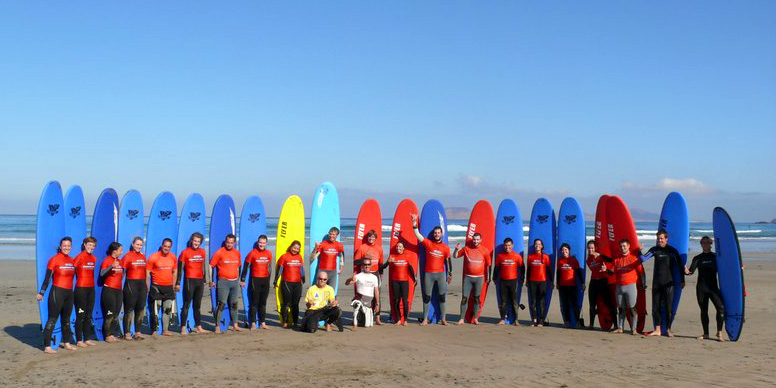
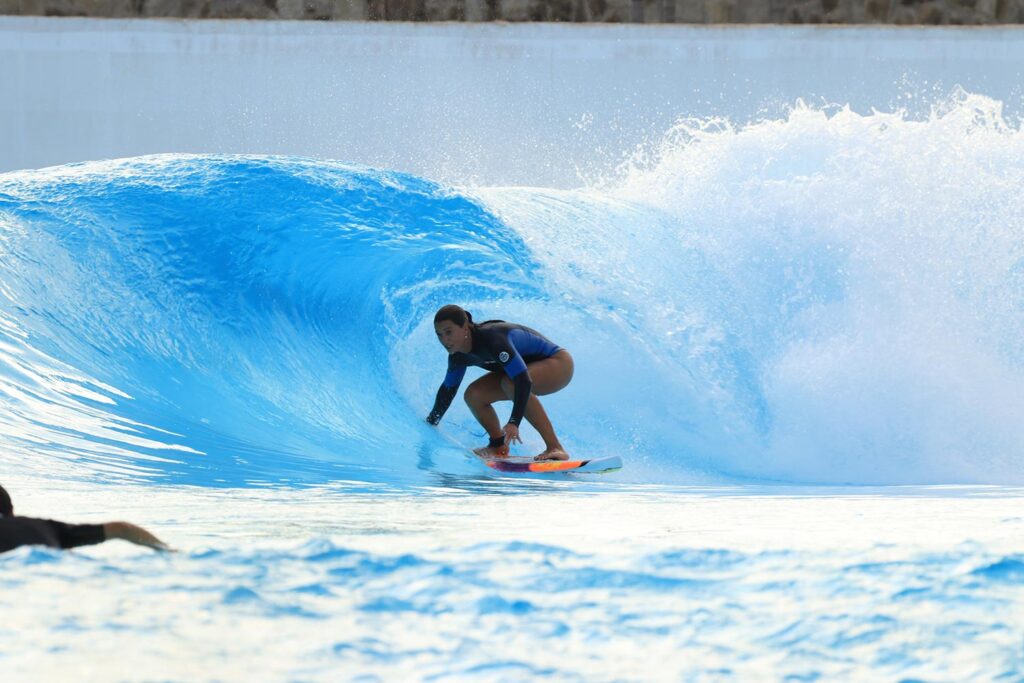




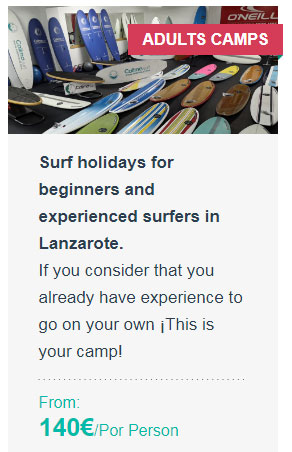


















Leave a comment
Your e-mail address will not be published. Required fields are marked with *.